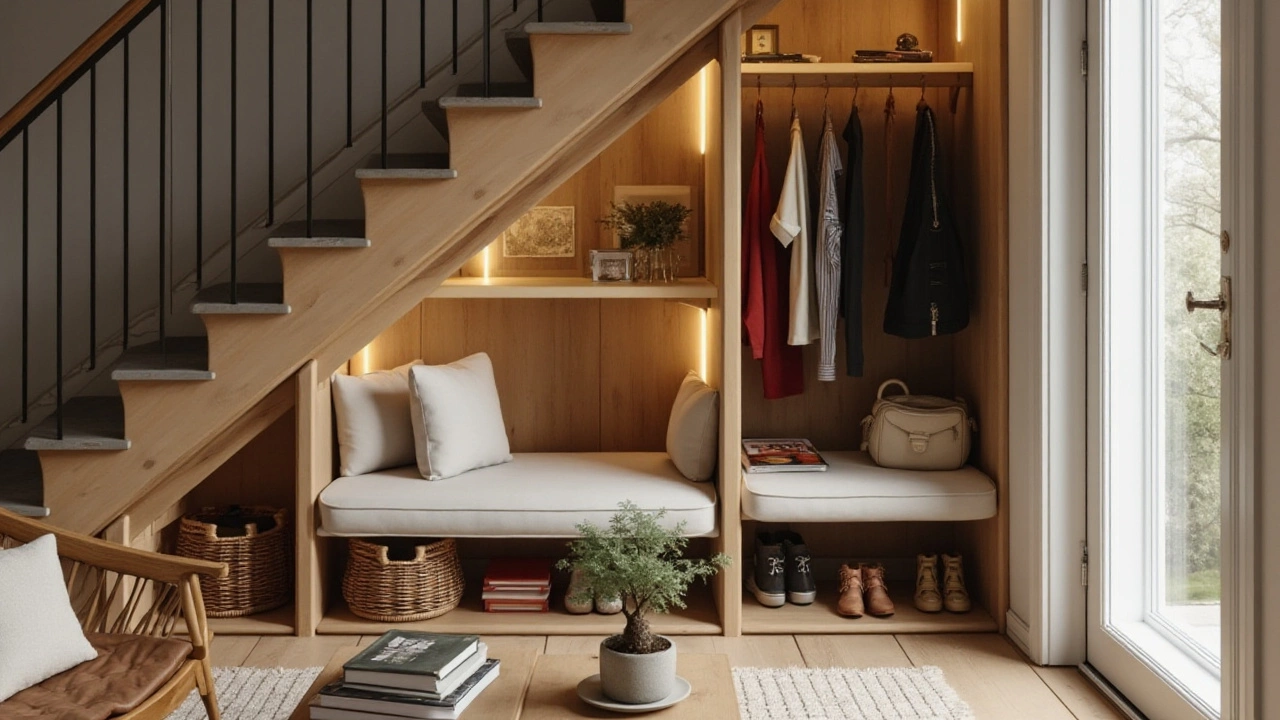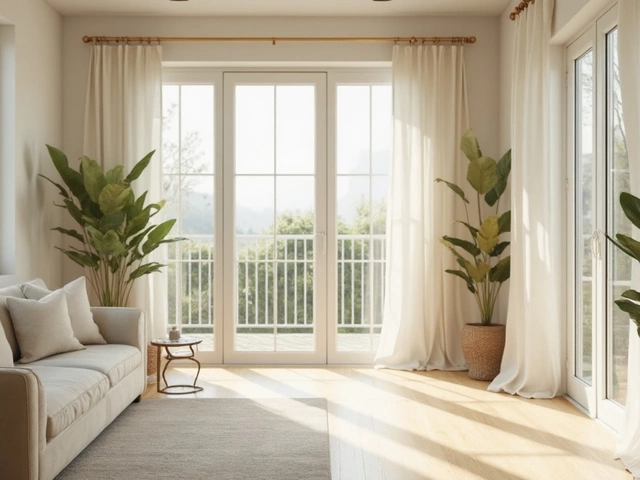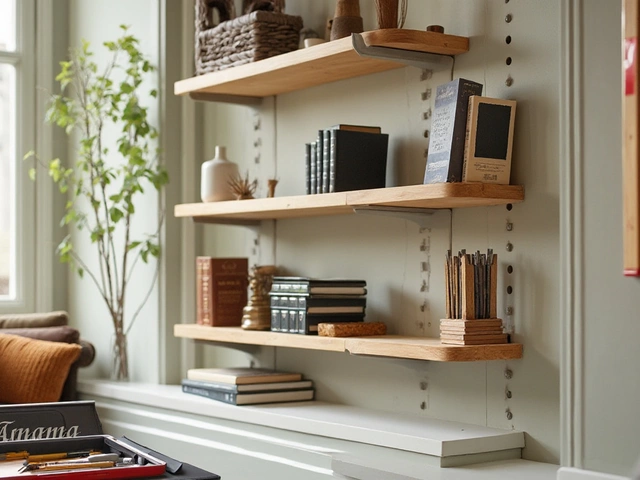Living in a small house can be a delightful experience, but it often comes with the challenge of finding enough space to store your belongings. The good news is that a compact home doesn't have to feel cramped and cluttered. With a bit of creativity and the right strategies, you can make the most of your limited space. It's all about finding smart storage solutions that fit your lifestyle and needs.
Imagine walking into your tidy, well-organized home and feeling a sense of calm instead of chaos. It all starts with understanding and utilizing the space you have. By implementing a few clever ideas, you can create a functional and stylish living environment. Whether it's using multipurpose furniture or exploring vertical storage options, this guide is here to help you every step of the way.
- Understanding Your Space
- Creative Storage Solutions
- Multipurpose Furniture
- Vertical Storage Hacks
- Decluttering and Organizing
- DIY Storage Ideas
Understanding Your Space
When you're living in a small house, it's vital to first understand the natural flow and limitations of your living space. This involves analyzing each room to identify how it is currently being used, as well as how it could function more efficiently. Take a moment to walk through your home and critically observe every corner, nook, and cranny. This process is not just about spotting areas for additional storage, but also about recognizing opportunities for improvement.
You might notice, for example, that the area under your staircase is empty, or that the wall above your desk is bare. These underused spots can be transformed into valuable storage with a little ingenuity. The key is to not just think horizontally, but also vertically—imagine extending your storage space from floor to ceiling. Observing your space with fresh eyes can reveal all sorts of potential that you might not have considered before.
One of the most powerful methods to achieve this is by sketching your space or using a simple room design app. Visualizing your environment gives a clearer picture, making it easier to decide where storage solutions like shelves, cabinets, or hooks can be placed. It's also beneficial to note the high-traffic areas that need to be kept clear for daily activities. Balancing functionality with design is essential, as a well-thought-out space can significantly enhance both comfort and efficiency in your home.
"The essence of interior design will always be about people and how they live. It's about the realities of what makes for an attractive, civilized, meaningful environment, not about fashion or what's in or what's out." – Albert Hadley
When you think about organizing, one idea is to categorize your belongings based on how frequently you use them. Items you reach for every day should be easily accessible, while things you use less often can be stored in less obvious places. This approach not only helps you maintain an organized home, but also ensures that you make the most of the available space without overwhelming it.
Understanding your space is the cornerstone of effective storage. By knowing your home inside and out, you can unlock its full potential, creating a living space that is both cozy and brilliantly organized. Taking the time to assess your surroundings thoughtfully is an investment in a clutter-free, serene environment.
Creative Storage Solutions
When it comes to maximizing storage in small homes, creativity is your best friend. Instead of viewing limited space as a constraint, think of it as an opportunity to innovate. The key is to find storage solutions that not only serve a practical purpose but also enhance the overall look and feel of your home. For instance, have you ever considered the potential of the area under your stairs? This often-overlooked space can be transformed into a haven for storing shoes, books, or even creating an intimate reading nook. By installing drawers or shelves, you can utilize every inch of this area efficiently.
Similarly, the walls of your home are not just for artwork and photos. They're prime real estate for storage. Think about installing floating shelves in the living room or kitchen. These shelves can hold anything from plants and decorative items to spices and cooking utensils. Floating shelves create an open and airy feel, making the space seem larger. If you've got a passion for crafts or have a growing collection of tools, pegboards are perfect for mounting on walls. They allow for easy organization with hooks and baskets while keeping everything in plain sight and within reach.
And let’s not forget about multipurpose furniture, which has truly revolutionized compact living. A coffee table with hidden compartments for storing magazines and board games, or a bed with drawers underneath, can significantly contribute to creating more space. The concept of functional furniture, which caters to multiple needs, is essential when dealing with limited square footage. Many companies now offer sleek designs for desks, dining tables, and sofas that can transform into beds, giving your home the versatility it needs.
Never underestimate the potential of seldom-used spaces, such as the tops of cabinets or the backs of doors. While it might seem unconventional, these areas can be surprisingly useful. Mount hooks or racks on the backs of closet and pantry doors to hold cleaning supplies, shoes, or accessories. This way, even small items have their dedicated place, which helps reduce clutter and keeps things organized. Meanwhile, storage boxes or baskets on top of kitchen cabinets can hold items that aren’t used daily, like holiday dishes or special occasion cookware.
There’s a saying in the world of interior design: "A place for everything and everything in its place.” By implementing creative storage solutions, you can ensure that every item in your home has a designated spot, thus reducing clutter and increasing functionality. And remember, decluttering is equally important. Regularly assess what items you truly need and what can be donated or discarded. Keeping your home organized is a continuous and rewarding process.
"Small spaces teach us about living with intention and cherishing every object we own," says Marie Kondo, a widely respected organizing expert renowned for her KonMari method. Her approach focuses on respecting the items we choose to keep by giving them a dedicated space, helping maintain a tidy and meaningful environment.
Creating a system that works for you is all part of building a home that supports your lifestyle. Embrace bold ideas and try new things, and soon you’ll find that living in a small house doesn’t limit what can be achieved. On the contrary, it offers an opportunity to curate a space that is uniquely yours, personalized and full of character, all beautifully tucked into a compact living environment.
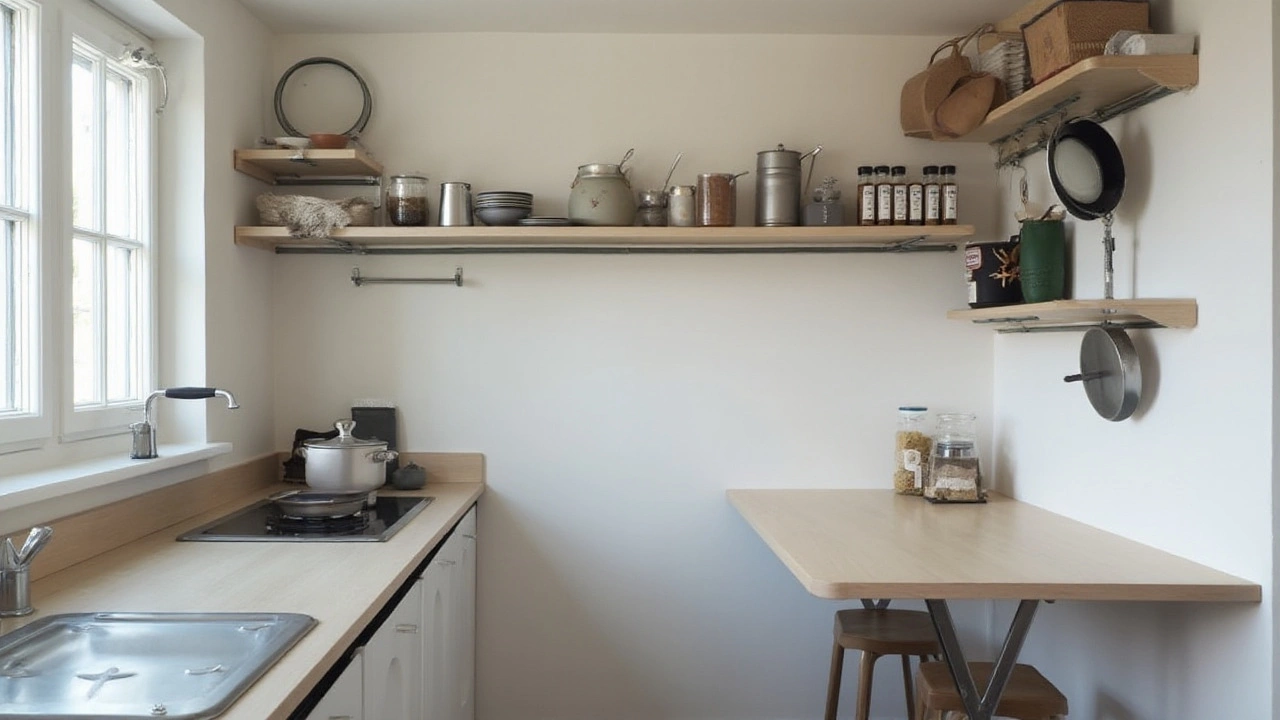
Multipurpose Furniture
When you're living in a compact space, every piece of furniture you bring into your home carries immense value. One of the smartest approaches to maximizing your small house storage is to invest in multipurpose furniture. These ingenious creations not only save space but also add functionality and style to your environment. The beauty of multipurpose furniture lies in its ability to perform more than just its primary function. For example, a sofa bed serves as a comfortable couch during the day and transforms into a guest bed at night, making it a perfect solution for those without a designated guest room. This versatility allows you to adapt your living space based on your needs, creating a flexible and efficient home.
Another great example of multipurpose furniture is an expandable dining table. During normal use, it can comfortably seat two to four people. However, when you have guests over, you can extend it to accommodate six to eight diners. This not only saves precious floor space on less busy days but also gives you the ability to host friends and family during special occasions. Storage ottomans that offer seating, surface space, and hidden storage are another practical addition to any small home. They provide a place to sit, serve as a coffee table, and hide away items that don't need to be on display.
According to interior designer Sarah Richardson, "In a small space, every piece of furniture should earn its keep. Look for items that serve multiple purposes to make the most of your square footage."
Shelving units with built-in work desks are also quite popular. They offer a perfect solution for those who need a home office but lack the spare room for one. These units maximize vertical storage, utilizing height rather than width, which is a clever way to preserve valuable floor area. Murphy beds remain a classic choice for studio apartments, where pulling down a bed from the wall at nighttime allows the room to double as a bedroom and a living space by day. They are especially useful in compact living solutions, turning your one-room apartment into a multi-room living environment without the need for actual walls.
For children's rooms, consider bunk beds with built-in drawers and shelves. This design consolidates sleeping quarters with essential storage, maintaining tidiness and efficiency in a space where toys and clothes tend to multiply magically. Imagine a child's play area that converts into a study zone with a pull-out desk, saving space for activities and learning. Multipurpose furniture has the ability to revolutionize how space is used, making each corner of your home count. As space becomes an increasing luxury, such innovations make it practical to achieve the best storage outcomes.
To put things into perspective, consider this table that illustrates some common multipurpose furniture items and their additional features:
| Furniture | Main Use | Additional Features |
|---|---|---|
| Sofa Bed | Seating | Transforms into a bed |
| Expandable Dining Table | Dining | Adjustable seating capacity |
| Storage Ottoman | Seating/Surface | Hidden storage space |
| Desk with Shelves | Workstation | Additional storage and display |
| Bunk Bed | Sleeping | Incorporated drawers and shelves |
Each piece on this list not only serves its primary function but adds value by offering additional uses, which is vital in organization ideas for small houses. They let you enjoy a clutter-free space while avoiding the need for excessive furniture that encroaches on limited room. So when furnishing a small home, always look for those unique items that simplify and maximize your habitat, letting versatility lead the way.
Vertical Storage Hacks
When living in a cozy, small house, every inch of space becomes precious, especially when you're trying to fit in a lot of life's little essentials. One of the best strategies you can use is looking towards the skies—well, your ceilings. Vertical storage is like turning your walls into superhero allies. Not only does it create more room, but it also draws the eyes upward, making spaces feel larger than they are. Begin by surveying your walls and imagining a blank canvas where possibilities are endless. Cabinets, shelves, and even hanging systems can transform narrow corridors and tiny rooms into spacious havens.
Install shelves that play double duty; one could keep spices at arm’s length in your kitchen while the other might house your favorite reads by your bed. The trick lies not in just putting up shelves but making smart use of angles and levels. Stagger cabinetry at various heights—this keeps things fresh and distracts from the small floor plan. For those who adore displaying collectibles or plants, staggered shelving creates a wonderful flow and adds character to any room. Consider floating bookshelves, which can hold a reserved set of books ready for when you're cozying down in your window nook.
Hanging storage solutions might work wonders as well. Rails or pegboards in the kitchen can organize utensils, pots, pans, and even cutting boards, keeping counters free and clear. Imagine an urban garden in the living room or kitchen nook using fragrant herbs or colorful plants on wall-mounted racks. Similarly, adding wall hooks in the entryway can beautifully manage coats, hats, and bags, creating an organized drop zone. It's amazing how such small additions can declutter and prompt a serene entry point into your home.
In a bedroom, using vertical storage can be magical. If your bed is on the shorter side, elevate it to introduce under-bed storage, while adding a headboard with built-in shelving for nighttime essentials like lamps, books, and glasses. High-mounted rails in closets can allow for the extra rod space. Additionally, vacuum-sealed bags can shrink down seasonal clothes, freeing up precious closet storage. Using the door space for hanging racks might seem cliché, but they work wonders with small accessories. Slip a shoe organizer over a door—it can hold much more than just shoes, like cleaning supplies or personal items.
An entryway table or a compact shoe rack might be another fantastic vertical space-saver. Use hooks above these to keep umbrellas and scarves off the floor. Let mirrors claim their space within your humble abode because they expand visuals and trick the eyes into perceiving more area. Bespoke hooks like antique iron, mod metal, and polished wood lend personality to any vertical space and are perfect for holding up decorative pieces from artworks to photo frames.
"By converting vertical space into storage, you don't just find a place for your stuff; you discover room for living," says renowned home organizing guru, Marie Kondo, emphasizing the impact of using vertical shelves to accentuate peaceful surroundings.
Finally, vertical storage doesn't just stop inside. Out in your garden, stackable planters, ladders-turned-plant-shelves, or hanging baskets can green up your abode in magical ways without foot-stamping on other essential spaces. These hacks offer a unique token of personality infused into every wall, while elegantly scapings on precious floor space. Keep your imagination open, and these inspirations will soon turn those vertical arenas into marvels of storage and style you wouldn’t have thought possible in any compact living space.
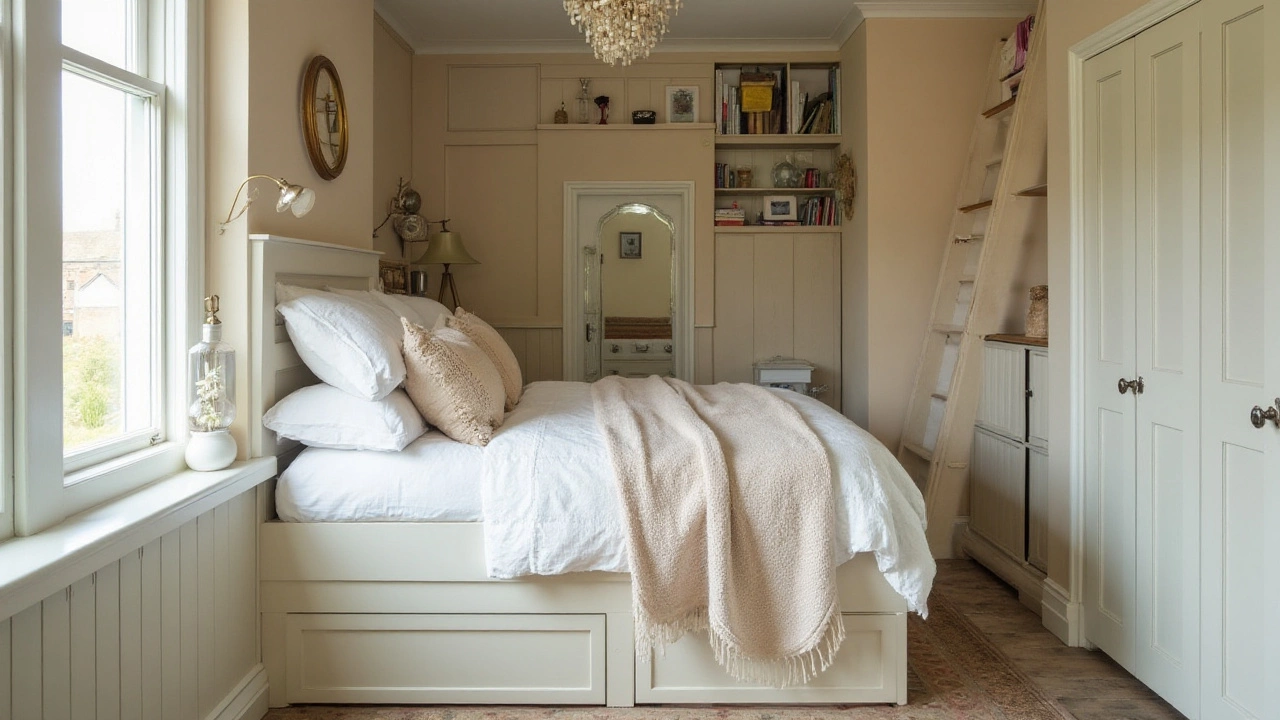
Decluttering and Organizing
When it comes to optimizing space in a small house, getting the decluttering and organizing right is an absolute must. It might feel daunting at first, but once you get the hang of it, you'll find the act of decluttering almost addictive. To start, embark on an adventure of separating items you genuinely use from those gathering dust. Many people find joy in a minimalist lifestyle by adopting the ‘one in, one out’ principle—a highly effective method where buying something new necessitates getting rid of something old. Consider setting up a donation box. Not only does this help you purge things responsibly, but it adds the glow of knowing your unneeded items are helping others.
Now, let’s talk organization—no matter what you decide to keep, how do you actually arrange it? Organization in a small house is all about visibility and access. Make the most of transparent storage options. Clear bins let you spot what's inside without rummaging through heaps of stuff. Utilize labels as your organizing superpower. No more forgotten boxes or unused expiration-dated supplies that could have saved you a trip to the grocery store. Stackable storage is another remedy for space woes. When drawers and surfaces are limited, going vertical will save the day.
"The quickest way to find calm in a crowded space is to know that every item has a home," says decluttering guru Marie Kondo.
Crafting a home that exudes serenity rather than chaos is about keeping it clean but also about inventive use of the space. Apply an ‘everything in its place’ mindset to surfaces like countertops or tables. Opt for furniture designs that make use of hidden storage. Beds with built-in drawers underneath or ottomans that conceal a treasure trove of items can unobtrusively expand your storage opportunities. Lastly, never underestimate the power of frequent and small clean-ups. A few minutes each day spent resetting your space allows you to keep mess from piling up into unmanageable mountains.
It's also worth considering using colorful storage solutions to not only brighten the atmosphere of your abode but to differentiate areas according to your needs. For instance, a yellow bin could be designated for kids' toys while a blue one might hold office supplies. Sorting can significantly contribute to a less chaotic home decor appearance. As part of your organization ritual, keep an inventory of key items such as cables and accessories manually or digitally. Several digital tools can remind you where you put things, thereby cutting down on the time spent looking for stuff.
Statistics show that the average home contains over 300,000 items. It's no wonder we often feel overwhelmed when tasked with organizing! Making a habit of regular purges and staying dedicated to a solid system can make the whole process more harmonious. Not only will your home be easier to maintain, but studies have shown that a tidy space can have remarkable effects on your mental health, leading to reduced stress and increased productivity.
DIY Storage Ideas
Diving into the world of DIY storage ideas can be both a rewarding and resourceful way to reclaim space in your home. When done right, DIY projects not only help solve storage issues but also add a personal touch to your living space. The beauty of DIY is that you can tailor solutions to your specific needs, creating something that not only fits your house but also reflects your personality. In a small house where every inch counts, why not put your creativity to work and tackle those storage challenges head-on?
A great starting point is to look around and identify areas that could double as storage spaces. For instance, under-bed storage is often overlooked but can save a significant amount of space. Creating custom storage boxes or rolling drawers to fit under your bed can hide away seasonal clothes or other items you don't use regularly, keeping your home tidy and spacious without spending a fortune. Another brilliant DIY idea is to utilize the backs of doors. Installing hooks or a simple pegboard on a door transforms it into a functional storage area for things like bags, scarves, or hats, making them easily accessible yet out of sight.
One common problem homeowners face is the lack of closet space. However, with some DIY savvy, you can easily create extra storage. Installing open shelves above doorways utilizes often-unused high space, providing an ideal spot for storing books or displaying decorative items. You can also create DIY organizers within closets. Shoeboxes or homemade dividers can help categorize items such as socks, belts, and accessories, preventing clutter and maximizing the space within your closet. Moreover, by using tension rods, you can hang spray bottles or other cleaning supplies under sink cabinets, a simple yet effective way to clear up counter space.
For those who love a good furniture flip, transforming an old wooden ladder into a stylish shelf serves as both storage and décor. By painting or staining the ladder to match your home’s aesthetic, it can hold plants, books, or decorative items, providing both function and flair. The same goes for refurbishing old crates as stackable storage solutions. These crates can be painted or left natural, used to store anything from toys to magazines, and can be arranged creatively against a wall.
While embarking on these projects, remember that creativity is key. As Albert Einstein once said,
"Creativity is intelligence having fun."Embrace this idea by thinking outside the box and coming up with storage solutions that work for your unique living situation. Engaging in DIY not only gives you practical storage solutions but also offers a sense of accomplishment and personalization. So gather your tools, roll up your sleeves, and let your imagination guide you to a more organized and visually appealing home.

